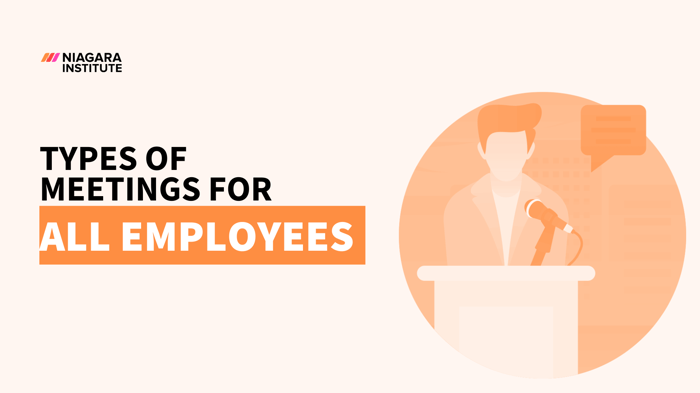6 min read
7 Free Management Meeting Templates and Tools
Whether it’s a monthly management meeting, an annual leadership summit, or an executive offsite, these meetings can become predictable and stale over...
4 min read
 Michelle Bennett
:
Jan 25, 2023 2:16:00 PM
Michelle Bennett
:
Jan 25, 2023 2:16:00 PM

Leading meetings is a significant component of the workweek for many in management positions. So much so, Harvard Business Review uncovered that, on average, leaders spend 23 hours a week hosting and participating in business meetings.
With so much of a leader’s time being dedicated to getting together to solve problems, receive updates, and share information, it’s best to be ready for the different types of meetings you may have to lead.

When you’re in management, leading 1:1 meetings is a significant part of your workday. Here are five of the most common 1:1 meetings you’ll be part of.
Check-in Meeting
Check-in meetings are dedicated time with each of your direct reports has with you on a regular basis. These meetings typically occur weekly or bi-weekly and focus on asking questions that build a trusting relationship, helping your team member with projects they’re working on, providing coaching and feedback, and discussing their goals and ambitions.
Performance Review Meeting
Having a performance conversation, whether it is a scheduled performance review or is needed to address poor performance, is a type of meeting everyone in management needs to be ready to have. To help you prepare, use the Performance Management Toolkit, which has many insightful articles, helpful templates, and valuable tools to feel primed to host performance discussions.
Career Discussion
While some leaders may shy away from career conversations with employees for fear that a team member may start looking elsewhere for a new job, it is actually important not to shy away from these meetings as they will help you understand what your team members are looking for out of their careers. These discussions also provide you with knowledge of what’s important for each individual and show your employee you’re invested in their success, which boosts their confidence, motivation, and engagement.
Touchpoint Meeting
Touchpoint meetings allow a leader to meet with an employee to get an update on their progress toward completing a goal, project, or work assignment. These meetings are commonly between a manager and their direct report; however, they can be between a senior leader and a junior employee, also known as skip-level meetings.
Skip-Level Meeting
A skip-level meeting, as the name suggests, is a meeting between a leader of leaders and an employee different that is not their direct report. These meetings happen one-on-one and do not include the employee’s immediate supervisor. Often, the goal of hosting these meetings is for a leader to gain insight, ideas, and feedback on the employee’s experience at the front line of a given department.
.png?width=700&height=394&name=Types%20of%20Group%20Meetings%20(1).png)
Group meetings, independent of the participants, are a common occurrence for people leaders. Here are 11 group meetings you will likely have to lead or participate in throughout your career.
Team Meeting
A standard meeting every people leader will often lead is a team meeting. Team meetings can consist of an intact team, such as a group of employees that work together every day, a project team that is brought together to achieve a specific goal, or a group of peers, such as a management or leadership team.
Kick-off Meeting
If you’re leading an initiative or a new project, you will likely bring together everyone involved for a kick-off meeting. When conducting these meetings, you will typically review the objective and goals, team members' roles, and the work back schedules and milestones that need to be achieved.
A management meeting is a group meeting where peers in leadership roles, typically the heads of each department, come together to share information to make strategic decisions about the organization. These meetings may also be called leadership meetings or executive meetings.
Board Meeting
While you might not have to lead a board meeting, if you’re a department leader or head of a company, you will likely be called to join these meetings to deliver updates. A board meeting is when the board of directors of an organization comes together to assess performance and formulate policies and strategies for the company.
Business Meetings with a Client or Vendor
Not all meetings you will need to lead will be with company employees. You’ll also need to be ready to host business meetings with external participants, such as a client meeting or a meeting with a vendor. These meetings bring together internal and external participants to discuss a given project.
Team Huddle
When you bring together your team for a quick update to prepare them for what needs to be done is called a team huddle. These short meetings may occur at the start of a shift, in the morning, or once a week as a forum for sharing information, creating team alignment, and motivating employees.
Department Meeting
Like a team meeting, you’ll want to be prepared to lead a department meeting. These are meetings where all employees in a given department come together to discuss relevant functional topics. The main difference between a team meeting and a departmental meeting is that in a departmental meeting, all participants in attendance may not be the meeting leader’s direct reports but do work together in the same business function.
Planning Meeting
When you’re responsible for a project or new initiative, it is common for a leader to host a planning meeting. A planning meeting is when a group, which may be comprised of employees and external partners or stakeholders, comes together to discuss and make decisions on a project's vision, scope, budget, and timelines. Typically, you would lead this meeting to generate consensus and commitment to take the first step in a new initiative.
Office Meeting
An office meeting is a group meeting that consists of all employees who work out of the same location. The purpose of these meetings is to provide information and discuss relevant topics pertaining to that specific office location.
A stand-up meeting is when a group of employees comes together for an informal, quick update meeting. The name stand-up meeting comes from the idea that employees stand together during the meeting to keep the meeting short. Leading these meetings aims to provide updates or progress on an initiative or project, discuss roadblocks, and hold each other accountable for what needs to get done.
Training Sessions and Workshops
There will be times as a leader when you will need to run a training session or workshop for employees at your organization. The purpose of these group meetings is to provide knowledge and help employees develop a skill relevant to their role. You may be tasked with creating the training content yourself or work with a provider who develops the learning curriculum for your team training program.

In your career, you may need to lead a company-wide meeting. These are meetings where all employees gather to hear company announcements, discuss company results, celebrate milestones and achievements, and provide updates on initiatives and topics pertaining to all employees.
All-Hands Meeting
All-hands meetings, also known as all-staff meetings, town halls, or all-employee meetings, typically occur a few times a year when all employees from all locations come together, virtually or in person, to hear announcements from senior management. These are effective meetings that aim to keep everyone in the organization informed on the state of the business and the path forward. These meetings are also used to announce change initiatives that affect everyone within the company.
.png)
6 min read
Whether it’s a monthly management meeting, an annual leadership summit, or an executive offsite, these meetings can become predictable and stale over...
.png)
4 min read
When you lead a meeting, your leadership abilities are front and center for everyone to see. While how you lead a meeting may not be a fair...
.png)
7 min read
We’ve all been there. Attending meetings where the leader drones on, a few people monopolize the conversation, and nothing is actually accomplished....